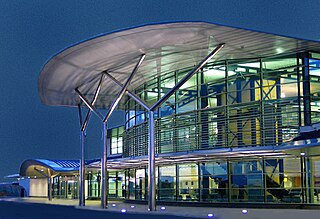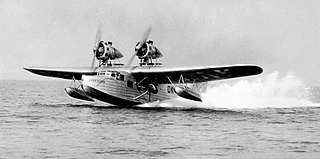| Founded | 1933 |
|---|---|
| Ceased operations | 1947 |
| Headquarters | Portsmouth Airport |
Jersey Airways was an airline that operated air services to and from the Channel Islands from 1933 until 1947, when it became part of British European Airways.
Contents

| Founded | 1933 |
|---|---|
| Ceased operations | 1947 |
| Headquarters | Portsmouth Airport |
Jersey Airways was an airline that operated air services to and from the Channel Islands from 1933 until 1947, when it became part of British European Airways.

Jersey Airways Limited was formed by Walter Thurgood on 9 December 1933. The first commercial service took place on 18 December; a passenger service from Jersey to Portsmouth. In the absence of a proper airport, the aircraft used St. Aubin's beach at West Park, St. Helier, and the airline had its maintenance base at Portsmouth Airport, (moving to Southampton Airport in 1935). On Sunday, 28 January 1934, the first flights began from Heston Aerodrome in Middlesex (with a special bus connection from London) to Jersey, in March 1934 flights began from Southampton, and during summer 1934, a service was operated to Paris. In its first full year, Jersey Airways carried 20,000 passengers, using a fleet of eight de Havilland DH.84 Dragons, each capable of carrying eight passengers. [1]
On 1 December 1934, Channel Islands Airways was registered as a holding company for Jersey Airways Ltd. and its subsidiary Guernsey Airways Ltd. which had been formed a week earlier. Shares were bought by the Great Western Railway and the Southern Railway. This allowed expansion, and in 1935, six four-engined de Havilland DH.86 Expresses and two de Havilland Dragon Rapides were introduced to replace the Dragons. On 8 January 1935, a service began to Rennes in France, although on 29 March 1935 it ceased. In April 1936, a Plymouth-Jersey service began, and in 1938 to Exeter, Dinard and Shoreham.
Jersey Airport opened on 10 March 1937, and Jersey Airways was able to operate a fixed timetable that no longer depended on the state of the tides. This also meant the company obtained the mail-carrying contract, freight traffic increased, and night flights could begin.
Meanwhile, in Guernsey, things were at a less advanced stage, and most air services were those by flying boats and amphibians. Guernsey Airways was very much smaller than its sister company in Jersey. Two flying boats were used: Saro Windhover G-ABJP and Saro Cloud G-ABXW, named "Cloud of Iona". In May 1939, Guernsey's new airport was opened. On 8 May 1939, Guernsey Airways began a service to Southampton, using a DH.86A (G-ADVK) and a DH.86B (G-AENR), later joined by a DH.95 Flamingo (G-AFUF). In June 1939, the prototype Flamingo (G-AFUE) was evaluated by Jersey Airways, but further orders for the type were frustrated by world events. [1]
At the outbreak of war on 3 September 1939, flights to the Channel Islands ceased. In November 1939, services resumed from Shoreham, under the direction of National Air Communications. On 13 June 1940, all scheduled air services between the United Kingdom and the Channel Islands were suspended. The following day, Jersey Airways began flying its staff and equipment to the United Kingdom mainland, and on 18–19 June 1940, the DH.86 fleet was used to evacuate 320 islanders to the mainland, before German forces occupied the islands on 1 July 1940. One DH.86 (G-ADVK) was on overhaul at Jersey at the time, and was abandoned; the rest of the fleet was impressed into RAF service. [2]
Following the liberation of the islands in 1945, Channel Islands Airways resumed scheduled services in June 1945, using ex-RAF DH.89A Dragon Rapides. Jersey Airways and Guernsey Airways flights then terminated at Southampton and at Croydon Airport. In May 1946, a Bristol 170 Wayfarer (G-AGVB) was loaned to Channel Islands Airways.
In 1947, the British government nationalised the UK airlines, including Jersey Airways, to form British European Airways (BEA). The Channel Islands authorities resisted this move, feeling that it was unacceptable to be dictated to by the British Government, who had no legal jurisdiction over the islands.[ citation needed ] However it was made plain that flights from the Channel Islands would not otherwise be allowed to land in England,[ citation needed ] and consequently on 1 April 1947, the airline staff, the eight Dragon Rapides and their routes all became part of BEA.[ citation needed ]
| Type | Registration | Name |
|---|---|---|
| DH.84 | G-ACMC | St. Brelade's Bay |
| DH.84 | G-ACMJ | St. Aubin's Bay |
| DH.84 | G-ACMO | St. Ouen's Bay |
| DH.84 | G-ACMP | St. Clement's Bay |
| DH.84 | G-ACNG | Portelet Bay |
| DH.84 | G-ACNH | Bouley Bay |
| DH.84 | G-ACNI | Bonne Nuit Bay |
| DH.84 | G-ACNJ | Rozel Bay |
| DH.86 | G-ACYF | Giffard Bay |
| DH.86 | G-ACYG | Grouville Bay |
| DH.86 | G-ACZN | St. Catherine's Bay |
| DH.86 | G-ACZO | Ouainé Bay |
| DH.86 | G-ACZP | Belcroute Bay |
| DH.86 | G-ACZR | La Saline Bay |
| DH.89 | G-ADBV | St. Ouen's Bay II |
| DH.89 | G-ADBW | (unnamed) |

British European Airways (BEA), formally British European Airways Corporation, was a British airline which existed from 1946 until 1974.

The de Havilland DH.89 Dragon Rapide is a 1930s short-haul biplane airliner developed and produced by British aircraft company de Havilland. Capable of accommodating 6–8 passengers, it proved an economical and durable craft, despite its relatively primitive plywood construction.

The de Havilland Express, also known as the de Havilland D.H.86, was a four-engined passenger aircraft manufactured by the de Havilland Aircraft Company between 1934 and 1937.

British Airways Ltd was a British airline company operating in Europe in the period 1935–1939. It was formed in 1935 by the merger of Spartan Air Lines Ltd, United Airways Ltd, and Hillman's Airways. Its corporate emblem was a winged lion.

Guernsey Airport is an international airport on the island of Guernsey and the largest airport in the Bailiwick of Guernsey. It is located in the Forest, a parish in Guernsey, 2.5 nautical miles southwest of St. Peter Port and features mostly flights to Great Britain and some other European destinations.

Aurigny Air Services Limited, commonly known as Aurigny, is the flag carrier airline of the Bailiwick of Guernsey with its head office next to Guernsey Airport in the Channel Islands, and wholly owned by the States of Guernsey since nationalisation in 2003. It operates passenger and freight services between the Channel Islands and the United Kingdom. Its main base is Guernsey Airport, with other aircraft and crew based at Alderney Airport. Aurigny is one of the longest serving regional airlines in the world, and is the second oldest established airline in Britain after Loganair. The origin of its name lies in the cognate across Norman languages for Alderney.

The de Havilland DH.84 Dragon is a successful small commercial aircraft that was designed and built by the de Havilland company.

Alderney Airport is the only airport on the island of Alderney, Guernsey. Built in 1935, Alderney Airport was the first airport in the Channel Islands. Located on the Blaye, it is the closest Channel Island airport to the south coast of England and the coast of France. Its facilities include a hangar, the Airport Fire Station, and avgas refuelling.
Blue Islands Limited is a British regional airline of the Channel Islands. Its head office is in Saint Peter, Jersey, and its registered office is in Saint Anne, Alderney. It operates scheduled services from and within the Channel Islands to the United Kingdom and Europe. Its main bases of operation are Guernsey Airport and Jersey Airport.
Railway Air Services (RAS) was a British airline formed in March 1934 by four railway companies and Imperial Airways. The airline was a domestic airline operating routes within the United Kingdom linking up with Imperial's services.
Guernsey is the second largest of the Channel Islands. It is part of the Common Travel Area, allowing passport-free travel to and from the United Kingdom or Jersey. Travel to and from mainland Europe requires a passport or an EU national identity document. Non EU citizens may need a visa.

Cambrian Airways was an airline based in the United Kingdom which ran operations from Cardiff Airport and Liverpool Airport between 1935 and 1974. It was incorporated into British Airways when BOAC, BEA, Cambrian and Northeast merged on 1 April 1974.

Morton Air Services was one of the earliest post-World War II private, independent British airlines formed in 1945. It mainly operated regional short-haul scheduled services within the British Isles and between the United Kingdom and Continental Europe. In 1953, Morton took over rival independent UK airline Olley Air Service. In 1958, Morton became part of the Airwork group. Morton retained its identity following the 1960 Airwork — Hunting-Clan merger that led to the creation of British United Airways (BUA). The reorganisation of the BUA group of companies during 1967/8 resulted in Morton being absorbed into British United Island Airways (BUIA) in 1968.

Jersey Airlines was an early post-World War II private, independent British airline formed in 1948. In 1952, the airline operated its first scheduled service. Four years later, British European Airways (BEA) took a 25% minority stake in Jersey Airlines and made it an "associate". In June 1958, a Jersey Airlines de Havilland Heron became the first commercial airliner to arrive at the newly reconstructed Gatwick Airport. In 1960, Jersey Airlines ordered four state-of-the-art Handley Page Dart Herald 200 series turboprops. By 1962, BEA had sold its 25% minority holding in Jersey Airlines. The same year, Jersey Airlines became part of the British United Airways (BUA) group of companies. In August 1963, Jersey Airlines changed its trading name to British United (C.I.) Airways. Following the BUA group's 1967/8 reorganisation, BUA (C.I.) was absorbed into British United Island Airways (BUIA) in November 1968.
United Airways Ltd was a British airline operating in 1935, ending as part of British Airways Ltd.

The 1936 Jersey Air Disaster occurred on 31 July 1936 when the Cloud of Iona, a Saro Cloud flying boat of Guernsey Airways, went missing on a flight between Guernsey and Jersey. All ten on board were assumed to have died.
Western Airways was an airline based in Weston-super-Mare, Somerset, England between 1932 and 1978. Before World War II, for a short period, it was the world's busiest airline. It survived WWII by using its aircraft engineering expertise.
Highland Airways Limited was established in Inverness, Scotland, by Ted Fresson in 1933 to provide passenger and freight air services between the Scottish mainland and the Northern Isles of Orkney and Shetland, and between their islands. The airline was taken over by Scottish Airways, absorbed by British European Airways in 1947.